Connecting Parking Facilities to the Electric Grid: A Vehicle-to-Grid Feasibility Study in a Railway Station’s Car Park
Abstract
:1. Introduction
2. Overview of Peak Shaving and Load Levelling
3. Case Study
3.1. Lighting Systems
3.2. Entry/Exit System
3.3. Video Surveillance System
3.4. Technical Room
3.5. Electric Vehicle Supply Equipment
3.6. Electric Vehicle
4. Analysis of the Energy Absorption of the Car Park
5. Design of the Photovoltaic System
5.1. Photovoltaic (PV) Panel Technology
5.2. PV Support Structure
5.3. PV Matching Panels/Inverters
5.4. Producibility of the Designed PV Plant
6. Smart Charging of the Electric Vehicles
6.1. Green Algorithm
6.2. Peak Shaving Algorithm
7. Conclusions
- From a technical point of view, the evolution of smart grids has yet to prove their robustness and reliability.
- From a technical perspective, the evolution of smart grids are yet to prove their robustness and reliability.
- From a regulatory perspective, an appropriate regulatory framework has to be defined in order to regulate the introduction of this new “active” load.
- From an economic viewpoint, in order to explore all the possible monetary advantages linked to this new paradigm, appropriate business plans need to be written alongside marketing campaigns that encourage the end user to connect their vehicles and enable operators to perform such activities described.
- Finally, from a political perspective, public administration ought to be sensitive to a change of direction towards more sustainable modes of transport. It will be very important to encourage and support these technologies, and provide appropriate planning in terms of both logistics and infrastructure.
Author Contributions
Funding
Conflicts of Interest
References
- IEA/OECD. Global EV Outlook 2018: Towards Cross-Modal Electrification. International Energy Agency. Available online: https://webstore.iea.org/download/direct/1045?filename=global_ev_outlook_2018.pdf (accessed on 29 May 2020).
- IEA/OECD. 3030 Campaign. International Energy Agency. Available online: https://www.iea.org/media/topics/transport/3030CampaignDocumentFinal.pdf (accessed on 29 May 2020).
- Ramos, G.A.; Rios, M.A. Connection Schemes for Electric Vehicle Supply Equipment Retrieved. 2012, pp. 1–2. Available online: https://ieeexplore.ieee.org/document/6955230 (accessed on 29 May 2020).
- Qian, K.; Zhou, C.; Allan, M.; Yuan, Y. Modeling of Load Demand Due to EV Battery Charging in Distribution Systems. IEEE Trans. Power Syst. 2010, 26, 4–9. [Google Scholar] [CrossRef]
- Monteiro, V.; Pinto, J.; Afonso, J.L. Operation Modes for the Electric Vehicle in Smart Grids and Smart Homes: Present and Proposed Modes. IEEE Trans. Veh. Technol. 2016, 65, 1007–1020. [Google Scholar] [CrossRef] [Green Version]
- Gungor, V.C.; Sahin, D.; Kocak, T.; Ergut, S.; Buccella, C.; Cecati, C.; Hancke, G.P. Smart grid and smart homes, Key players and pilot projects. IEEE Ind. Electron. Mag. 2012, 6, 18–34. [Google Scholar] [CrossRef]
- Liu, C.; Chau, K.T.; Wu, D.; Gao, S. Opportunities and challenges of vehicle-to-home, vehicle-to-vehicle, and vehicle-to-grid technologies. Proc. IEEE 2013, 101, 2409–2427. [Google Scholar] [CrossRef] [Green Version]
- Habib, S.; Kamran, M. A Novel Vehicle-to-Grid Technology with Constraint Analysis-A Review. In Proceedings of the International Conference on Emerging Technologies (ICET), Islamabad, Pakistan, 8–9 December 2014. [Google Scholar]
- Uddin, K.; Dubarry, M.; Glick, M.B. The viability of vehicle-to-grid operations from a battery technology and policy perspective. Energy Policy 2018, 113, 342–347. [Google Scholar] [CrossRef]
- Berger, L.; Iniewski, K. Smart Grid, Applications, Communications and Security; Wiley: Hoboken, NJ, USA, 2012. [Google Scholar]
- Binding, C.; Gatenbain, D.; Jansen, B.; Sundostroem, O.; Andersen, P.; Marra, F.; Træholt, C. Electric Vehicle Fleet Integration in the Danish EDISON Project. Presented at 2010 IEEE Power & Energy Society General Meeting, Providence, RI, USA, 25–29 July 2010. [Google Scholar] [CrossRef] [Green Version]
- Østergaard, J.; Foosnæs, A.; Xu, Z.; Mondorf, T.; Andersen, C.; Holthusen, S.; Holm, T.; Bendtsen, M.; Behnke, K. Electric Vehicles in Power Systems with 50% Wind Power Penetration: The Danish Case and the EDISON programme. Presented at European Conference on Electricity & Mobility, Wurzbug, Germany, 26–30 July 2009. [Google Scholar]
- Surender Reddy, S.; Bijwe, P.; Abhyankar, A. Real-Time Economic Dispatch Considering Renewable Power Generation Variability and Uncertainty over Scheduling Period. IEEE Syst. J. 2015, 9, 1440–1451. [Google Scholar] [CrossRef]
- Khan, S.U.; Mehmood, K.K.; Haider, Z.M.; Bukhari, S.B.A.; Lee, S.-J.; Rafique, M.K.; Kim, C.-H. Energy Management Scheme for an EV Smart Charger V2G/G2V Application with an EV Power Allocation Technique and Voltage Regulation. Appl. Sci. 2018, 8, 648. [Google Scholar] [CrossRef] [Green Version]
- De Carne, G.; Zou, Z.; Buticchi, G.; Liserre, M.; Vournas, C. Overload Control in Smart Transformer-Fed Grid. Appl. Sci. 2017, 7, 208. [Google Scholar] [CrossRef] [Green Version]
- Haider, Z.M.; Mehmood, K.K.; Rafique, M.K.; Khan, S.U.; Lee, S.J.; Kim, C.H. Water-filling algorithm based approach for management of responsive residential loads. J. Mod. Power Syst. Clean Energy 2018, 6, 118–131. [Google Scholar] [CrossRef] [Green Version]
- Jhala, K.; Natarajan, B.; Pahwa, A.; Erickson, L. Coordinated Electric Vehicle Charging for Commercial Parking Lot with Renewable Energy Sources. Electr. Power Compon. Syst. 2017, 45, 344–353. [Google Scholar] [CrossRef]
- Mehmood, K.K.; Khan, S.U.; Lee, S.J.; Haider, Z.M.; Rafique, M.K.; Kim, C.H. Optimal sizing and allocation of battery energy storage systems with wind and solar power DGs in a distribution network for voltage regulation considering the lifespan of batteries. IET Renew. Power Gener. 2017, 11, 1305–1315. [Google Scholar] [CrossRef]
- Khosrojerdi, F.; Taheri, S.; Taheri, H.; Pouresmaeil, E. Integration of Electric Vehicles into a Smart Power Grid: A Technical Review. In Proceedings of the IEEE Electrical Power and Energy Conference (EPEC), Ottawa, ON, Canada, 12–14 October 2016. [Google Scholar]
- Knezović, K.; Martinenas, S.; Andersen, P.B.; Zecchino, A.; Marinelli, M. Enhancing the role of EVs in the grid: Field validation of multiple ancillary services provision. IEEE Trans. Transp. Electrif. 2017, 3, 201–209. [Google Scholar] [CrossRef] [Green Version]
- Project, P. Parker | Parker-Project. 2016. Available online: http://parker-project.com/ (accessed on 4 May 2020).
- Martinenas, S.; Knezovic, K.; Marinelli, M. Management of Power Quality Issues in Low Voltage Networks using Electric Vehicles: Experimental Validation. IEEE Trans. Power Deliv. 2017, 32, 971–979. [Google Scholar] [CrossRef] [Green Version]
- Parker Project. World’srst Cross-Bran d V2G Demonstration Conducted in Denmark. 2017. Available online: http://parker-project.com/wp-content/uploads/2017/11/Worlds-rst-cross-brand-V2G-demonstration-conducted-in-Denmark.pdf (accessed on 4 May 2020).
- Marinelli, M.; Martinenas, S.; Knezović, K.; Andersen, P.B. Validating a centralized approach to primary frequency control with series-produced electric vehicles. J. Energy Storage 2016, 7, 63–73. [Google Scholar] [CrossRef]
- Rezkalla, M.; Zecchino, A.; Martinenas, S.; Prostejovsky, A.M.; Marinelli, M. Comparison between Synthetic Inertia and Fast Frequency Containment Control on Single Phase EVs in a Microgrid. Appl. Energy 2018, 210, 764–775. [Google Scholar] [CrossRef] [Green Version]
- Longo, M.; Lutz, N.; Daniel, L.; Zaninelli, D.; Pruckner, M. Towards an impact study of electric vehicles on the Italian electric power system using simulation techniques. In Proceedings of the 2017 IEEE 3rd International Forum on Research and Technologies for Society and Industry (RTSI), Modena, Italy, 11–13 September 2017. [Google Scholar]
- Perujo, A.; Ciuffo, B. The introduction of electric vehicles in the private fleet: Potential impact on the electricity supply and on the environment. A case study for the Province Milan, Italy. Energy Policy 2010, 38, 4549–4561. [Google Scholar] [CrossRef]
- Ekman, C.K. On the synergy between large electric vehicle fleet and high wind penetration—An analysis of the Danish case. Renew. Energy 2011, 36, 546–553. [Google Scholar] [CrossRef]
- Hartmann, N.; Özdemir, E. Impact of different utilization scenarios of electric vehicles on the German grid in 2030. J. Power Sources 2011, 196, 2311–2318. [Google Scholar] [CrossRef]
- Brenna, M.; Corradi, A.; Foiadelli, F.; Longo, M.; Yaici, W. Numerical simulation analysis of the impact of photovoltaic systems and energy storage technologies on centralised generation: A case study for Australia. Int. J. Energy Environ. Eng. 2020, 11, 9–31. [Google Scholar] [CrossRef] [Green Version]
- Kempton, W.; Tomic, J. Vehicle-to-grid power implementation: From stabilising the grid to supporting large-scale renewable energy. J. Power Sources 2005, 144, 280–294. [Google Scholar] [CrossRef]
- Tomic, J.; Kempton, W. Using fleets of electric-drive vehicles for grid support. J. Power Sources 2007, 168, 459–468. [Google Scholar] [CrossRef]
- Sovacool, B.K.; Hirsh, R.F. Beyond batteries: An examination of the benefits and barriers to plug-in hybrid electric vehicles (PHEVs) and a vehicles-to-grid (V2G) transition. Energy Policy 2009, 37, 1095–1103. [Google Scholar] [CrossRef]
- Zhang, Q.; Tezuka, T.; Ishihara, K.N.; Mclellan, B.C. Integration of PV power into future low-carbon electricity systems with EV and HP in Kansai Area, Japan. Renew. Energy 2012, 44, 99–108. [Google Scholar] [CrossRef]
- Mwasilu, F.; Justo, J.J.; Kim, E.K.; Do, T.D.; Jung, J.W. Electric vehicles and smart grid interaction: A review on vehicle to grid and renewable energy sources integration. Renew. Sustain. Energy Rev. 2014, 34, 501–516. [Google Scholar] [CrossRef]
- Drude, L.; Junior, L.C.P.; Rüther, R. Photovoltaics (PV) and electric vehicle-to-grid (V2G) strategies for peak demand reduction in urban regions in Brazil in a smart grid environment. Renew. Energy 2014, 68, 443–451. [Google Scholar] [CrossRef]
- Habib, S.; Kamran, M.; Rashid, U. Impact analysis of vehicle-to-grid technology and charging strategies of electric vehicles on distribution networks—A review. J. Power Sources 2015, 277, 205–214. [Google Scholar] [CrossRef]
- Van der Kam, M.; van Sark, W. Smart charging of electric vehicles with photovoltaic power and vehicle-to-grid technology in a microgrid; a case study. Appl. Energy 2015, 152, 20–30. [Google Scholar] [CrossRef] [Green Version]
- Mozafar, M.R.; Amini, M.H.; Moradi, M.H. Innovative appraisement of smart grid operation considering large-scale integration of electric vehicles enabling V2G and G2V systems. Electr. Power Syst. Res. 2018, 154, 245–256. [Google Scholar] [CrossRef]
- Uddin, K.; Jackson, T.; Widanage, W.D.; Chouchelamane, G.; Marco, J. On the possibility of extending the lifetime of lithium-ion batteries through optimal V2G facilitated by an integrated vehicle and smart-grid system. Energy 2017, 13315, 710–722. [Google Scholar] [CrossRef]
- Das, H.S.; Rahman, M.M.; Li, S.; Tan, C.W. Electric vehicles standards, charging infrastructure, and impact on grid integration: A technological review. Renew. Sustain. Energy Rev. 2020, 120, 109618. [Google Scholar] [CrossRef]
- Ioakimidis, C.S.; Thomas, D.; Rycerski, P.; Genikomsakis, K.N. Peak shaving and valley filling of power consumption profile in non-residential buildings using an electric vehicle parking lot. Energy 2018, 1481, 148–158. [Google Scholar] [CrossRef]
- Zhang, L.; Jabbari, F.; Brown, T.; Samuelsen, S. Coordinating plug-in electric vehicle charging with electric grid: Valley filling and target load following. J. Power Sources 2014, 267, 584–597. [Google Scholar] [CrossRef]
- Fazelpour, F.; Vafaeipour, M.; Rahbari, O.; Rosen, M.A. Intelligent optimization to integrate a plug-in hybrid electric vehicle smart parking lot with renewable energy resources and enhance grid characteristics. Energy Convers. Manag. 2014, 77, 250–261. [Google Scholar] [CrossRef]
- Hota, A.R.; Juvvanapudi, M.; Bajpai, P. Issues and solution approaches in PHEV integration to smart grid. Renew. Sustain. Energy Rev. 2014, 30, 217–229. [Google Scholar] [CrossRef]
- Tan, K.M.; Ramachandaramurthy, V.K.; Yong, J.Y. Integration of electric vehicles in smart grid: A review on vehicle to grid technologies and optimization techniques. Renew. Sustain. Energy Rev. 2016, 53, 720–732. [Google Scholar] [CrossRef]
- Liu, J.; Zhang, T.; Zhu, J.; Ma, T. Allocation optimization of electric vehicle charging station (EVCS) considering with charging satisfaction and distributed renewables integration. Energy 2018, 164, 560–574. [Google Scholar] [CrossRef]
- Hariri, A.M.; Hashemi-Dezaki, H.; Hejazi, M.A. A novel generalized analytical reliability assessment method of smart grids including renewable and non-renewable distributed generations and plug-in hybrid electric vehicles. Reliab. Eng. Syst. Saf. 2020, 196, 106746. [Google Scholar] [CrossRef]
- Sultana, U.; Khairuddin, A.B.; Sultana, B.; Rasheed, N.; Qazi, S.H.; Malik, N.R. Placement and sizing of multiple distributed generation and battery swapping stations using grasshopper optimizer algorithm. Energy 2018, 165, 408–421. [Google Scholar] [CrossRef]
- Reuters. Nissan Leaf Gets Approval for Vehicle-To-Grid Use in Germany. 23 October 2018. Available online: https://www.reuters.com/article/us-autos-electricity-germany/nissan-leaf-approved-for-vehicle-to-grid-use-in-germany-idUSKCN1MX1AH (accessed on 26 May 2019).
- Nissan Leaf 2018. Available online: https://www-europe.nissan-cdn.net/content/dam/Nissan/gb/brochures/Vehicles/Nissan_Leaf_UK.pdfgermany/nissan-leaf-approved-for-vehicle-to-grid-use-in-germany-idUSKCN1MX1AH (accessed on 26 May 2019).
- Robalino, D.M.; Kumar, G.; Uzoechi, L.; Chukwu, U.C.; Mahajan, S.M. Design of a Docking Station for Solar Charged electric and Fuel Cell Vehicles. In Proceedings of the International Conference on Clean Electrical Power (ICCEP), Capri, Italy, 9–11 June 2009; pp. 655–660. [Google Scholar]
- Chukwu, U.C.; Mahajan, S.M. V2G Parking lot with PV Rooftop for Capacity Enhancement of a Distribution System. IEEE Trans. Sustain. Energy 2014, 5, 119–127. [Google Scholar] [CrossRef]
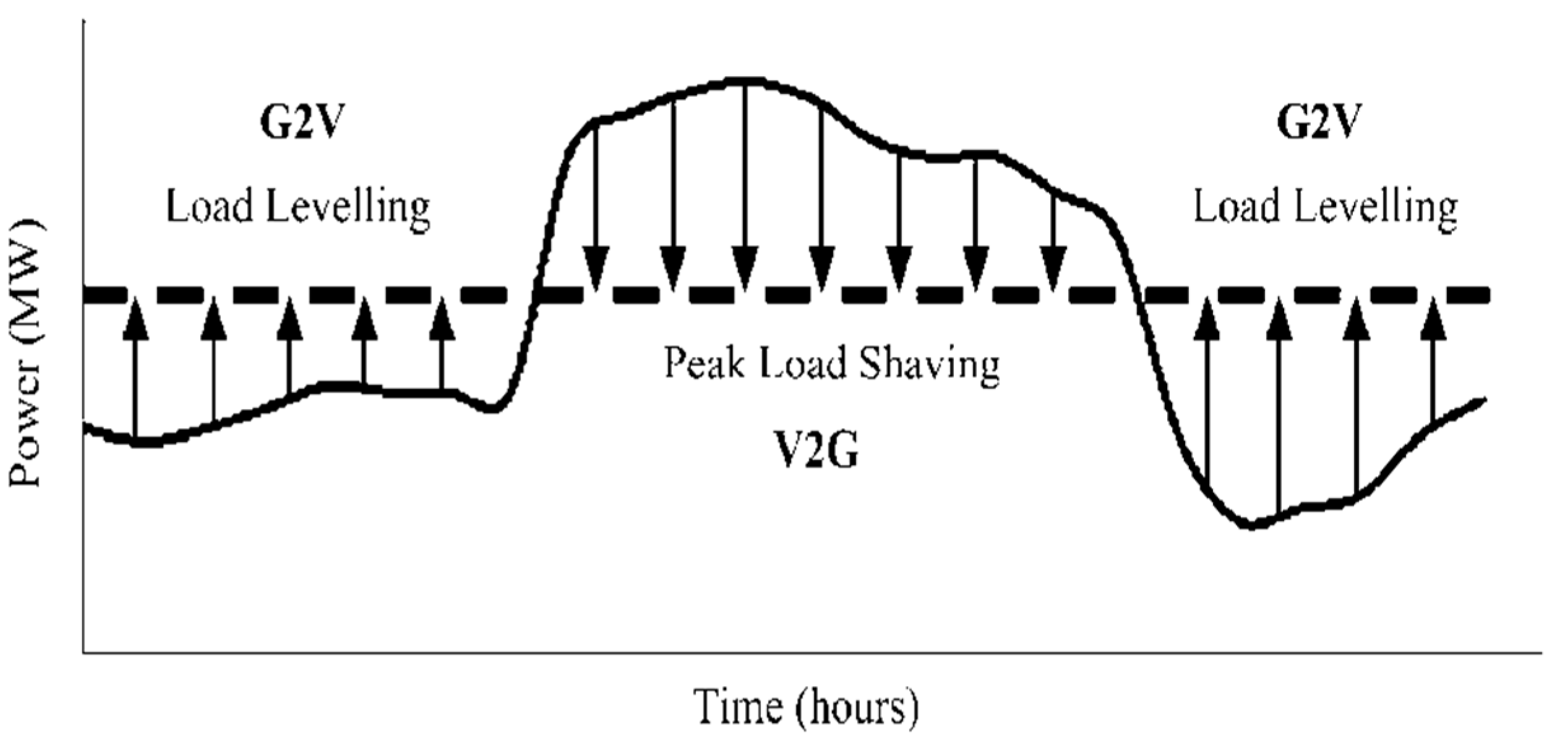
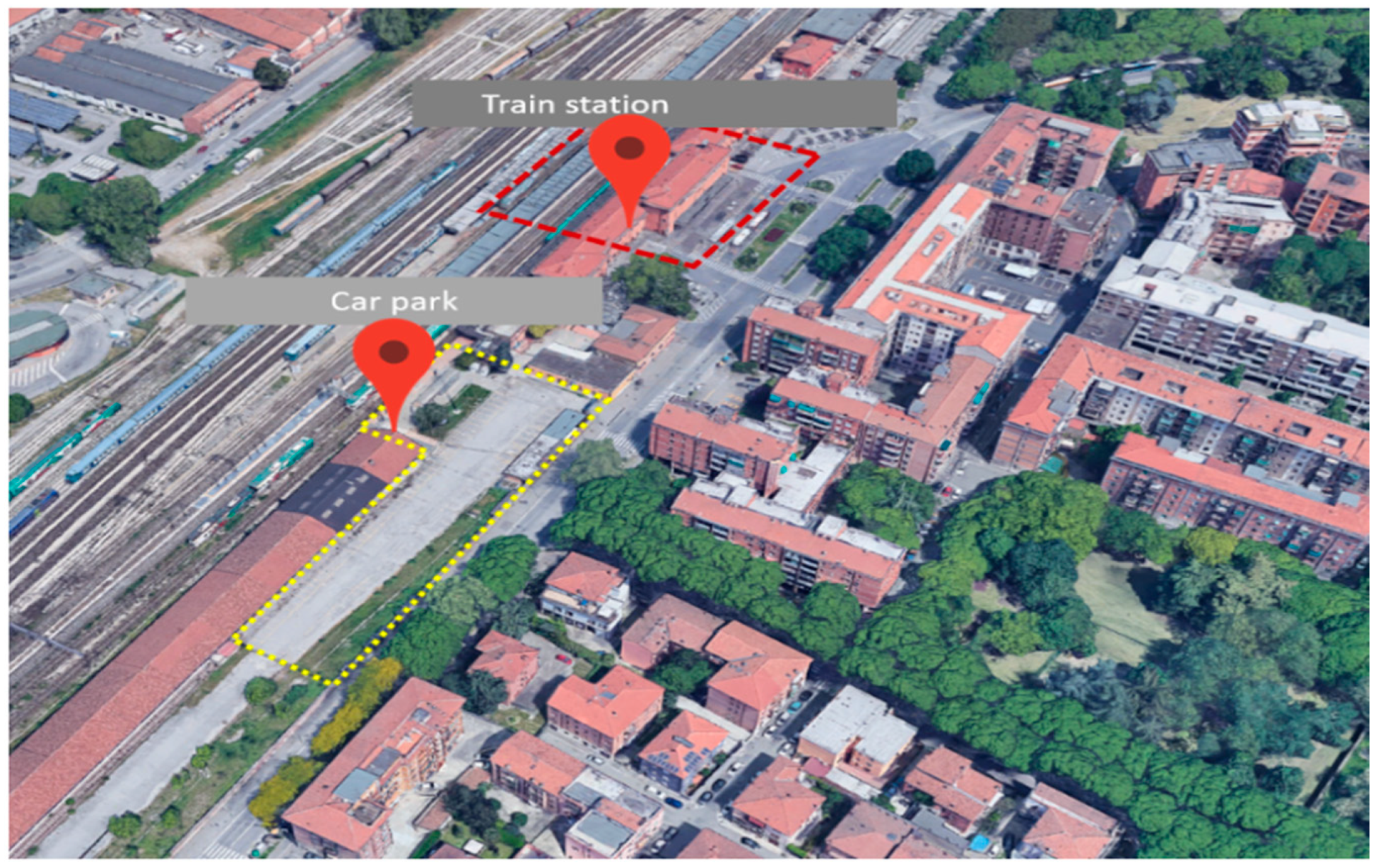


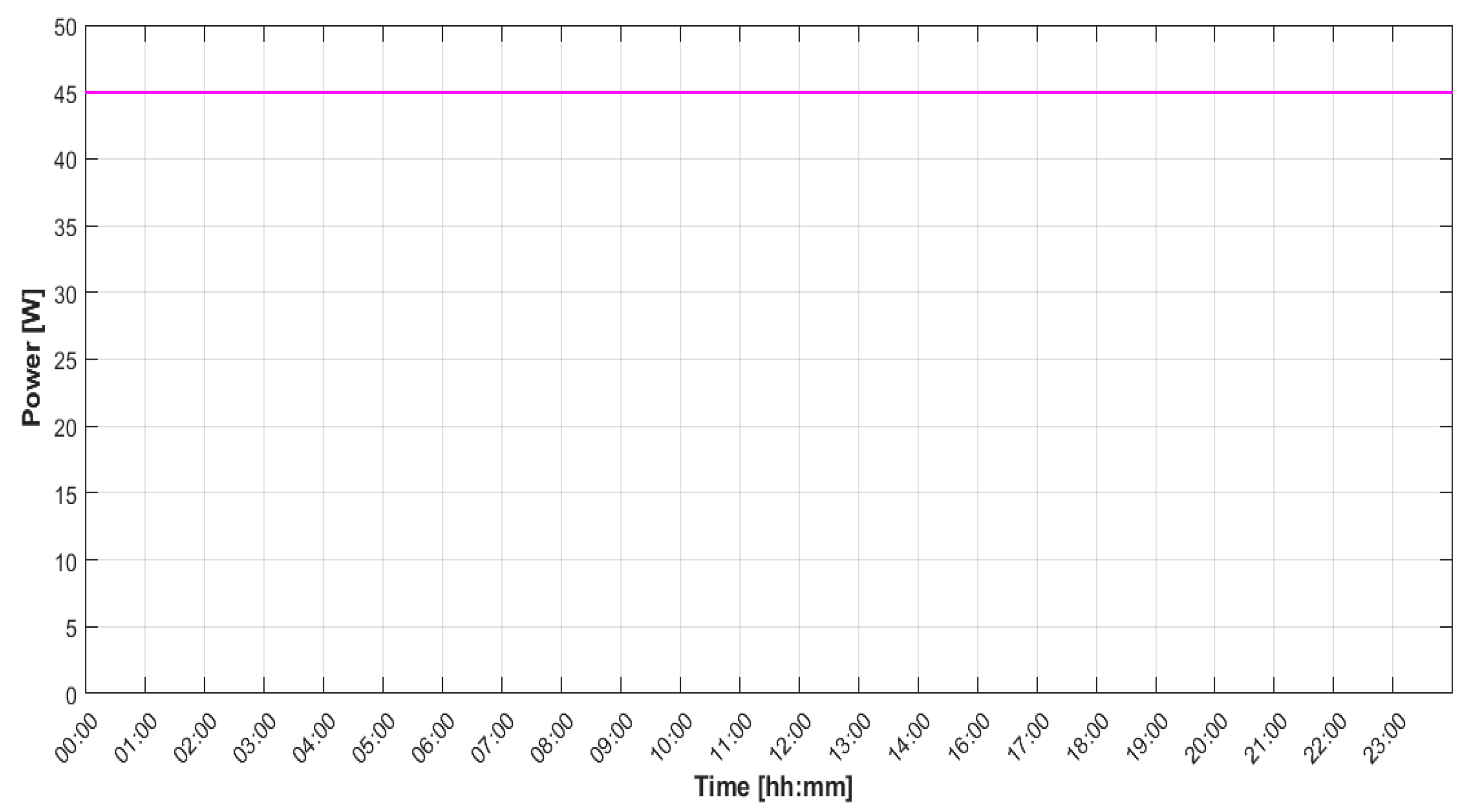


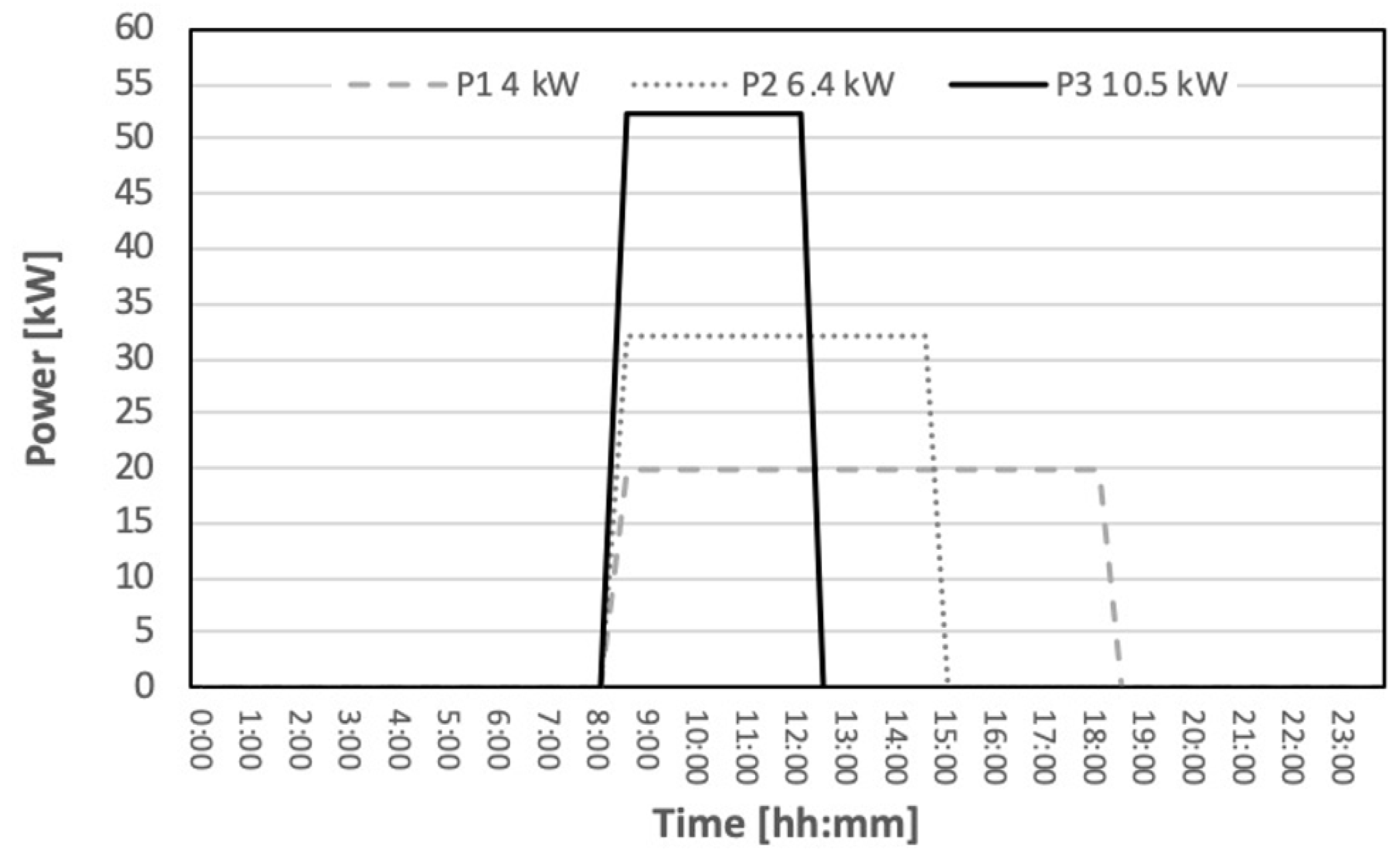

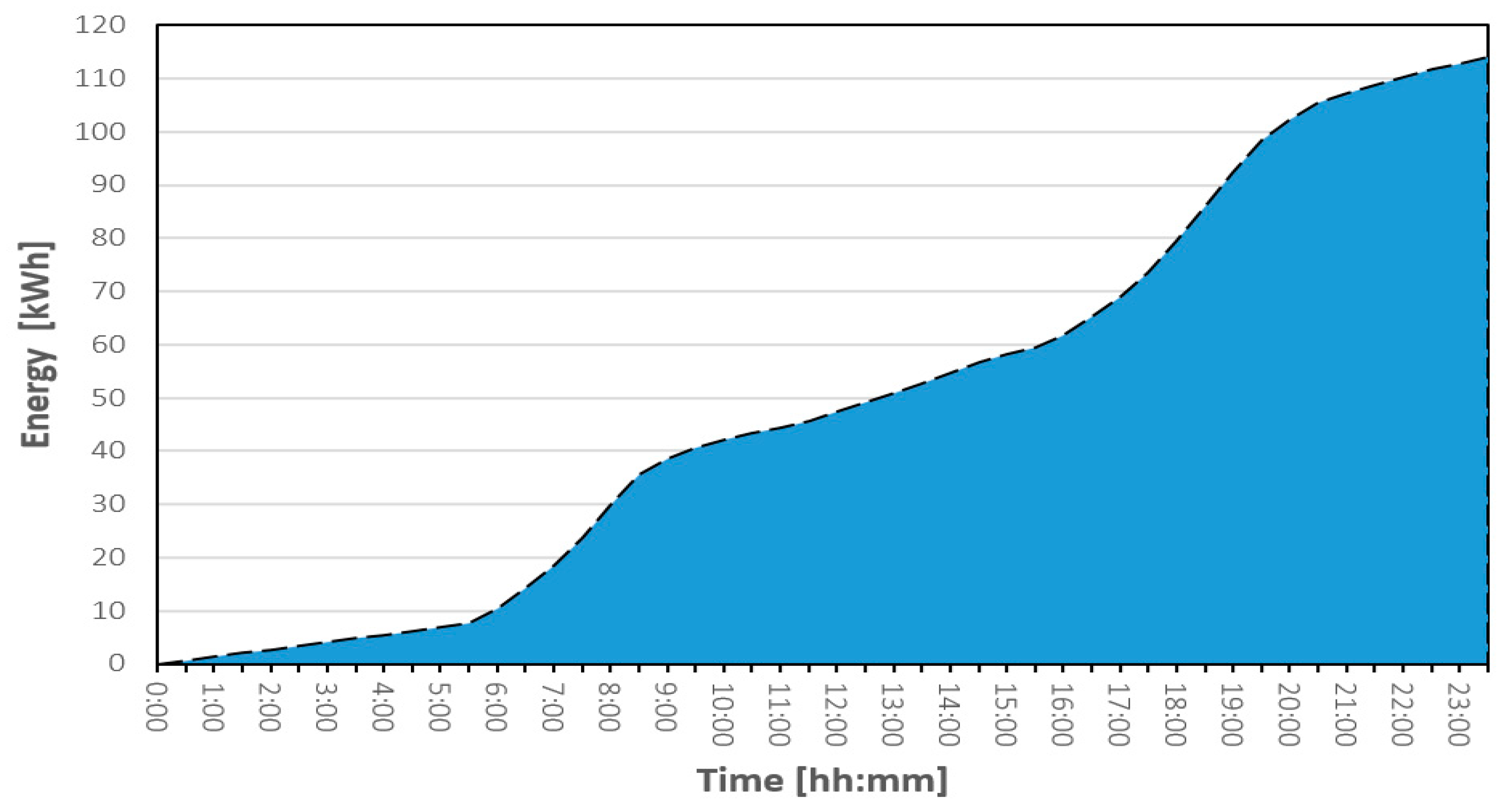
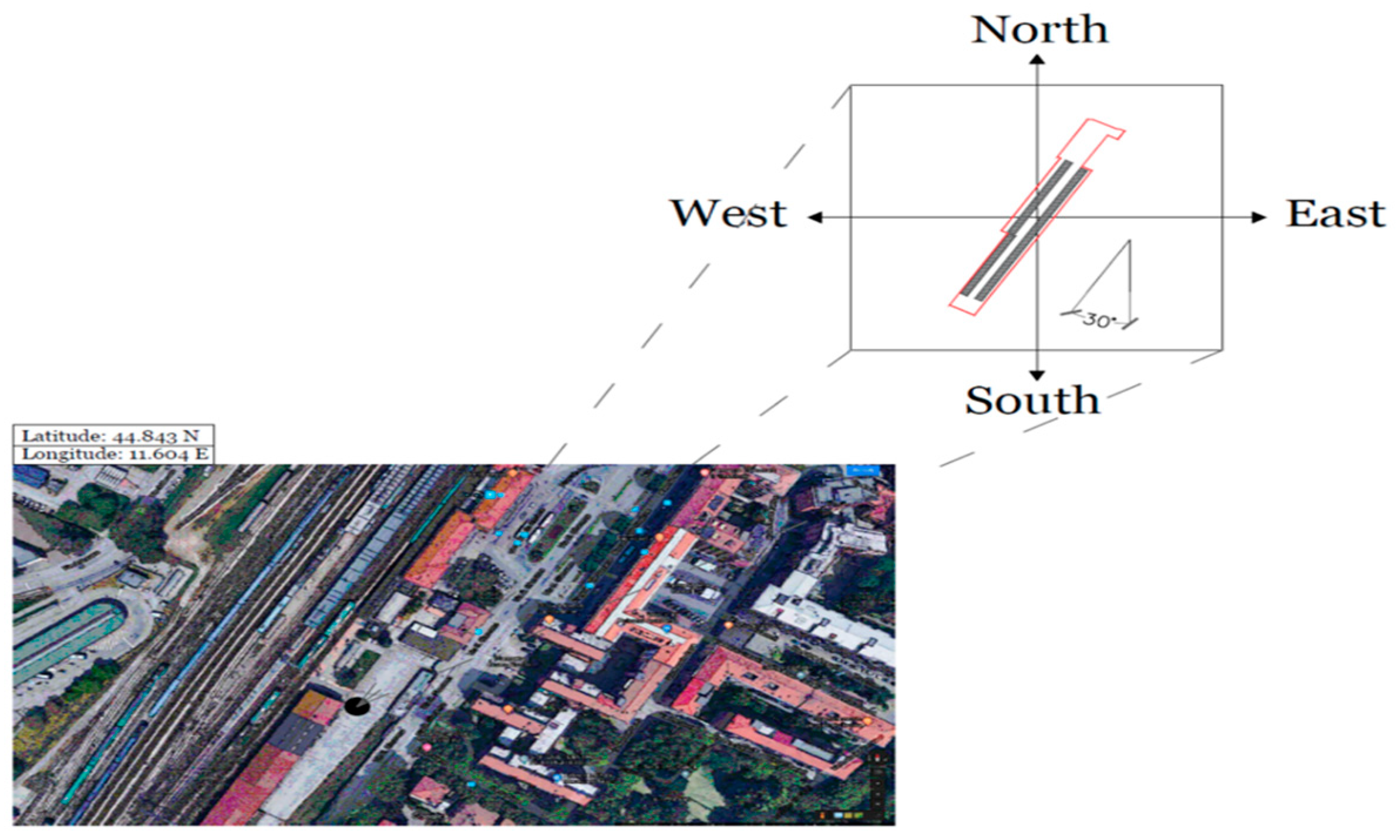



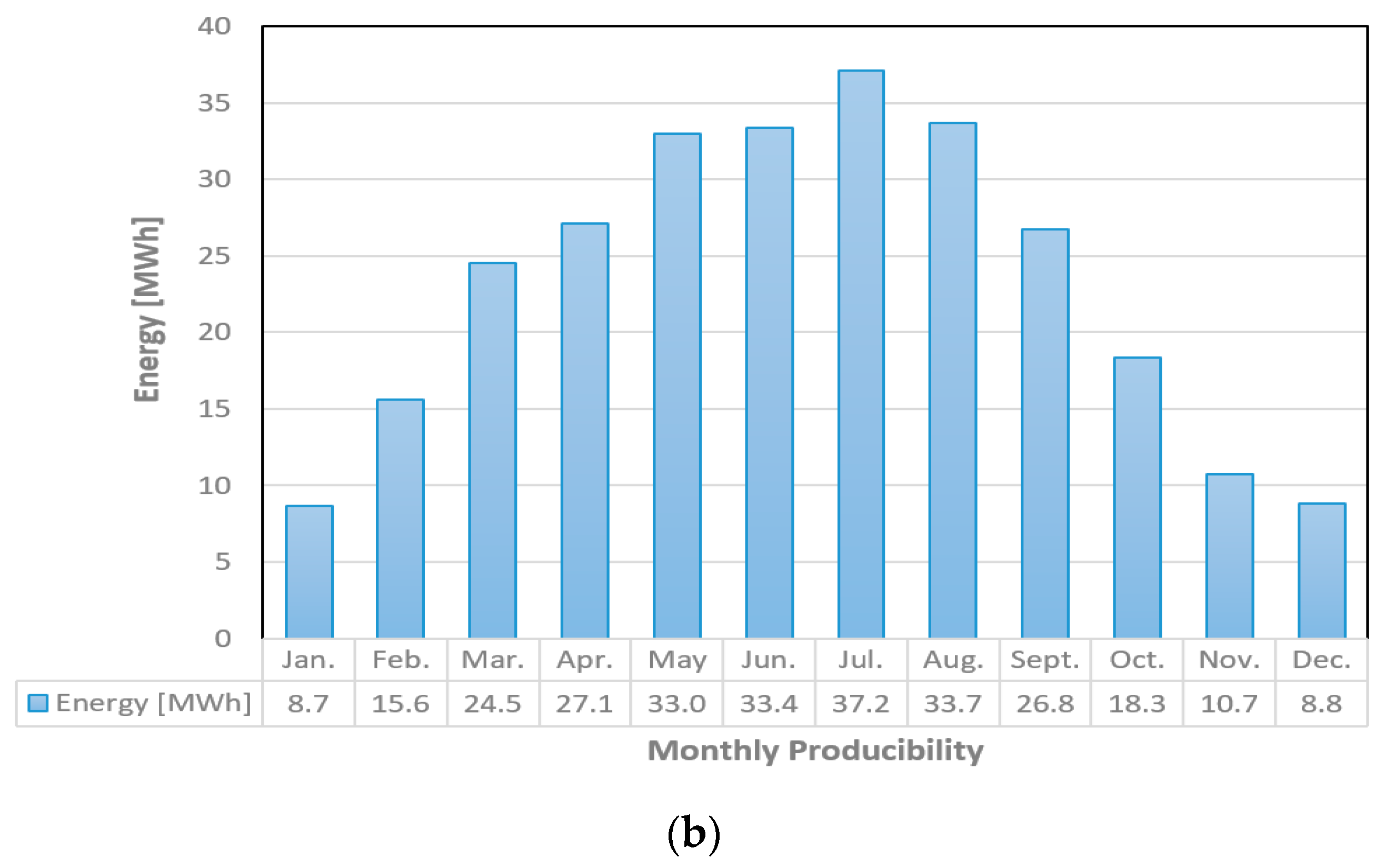
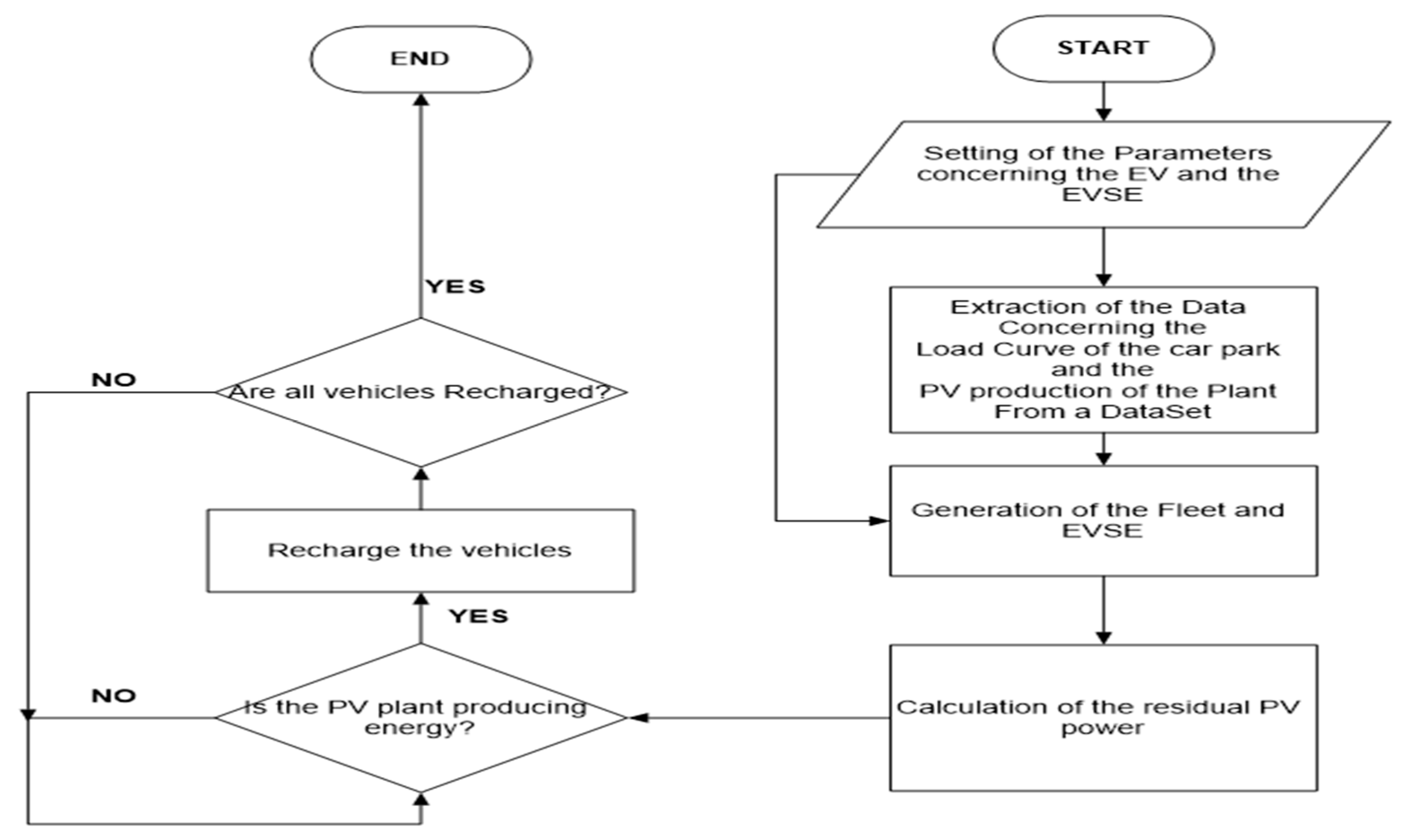

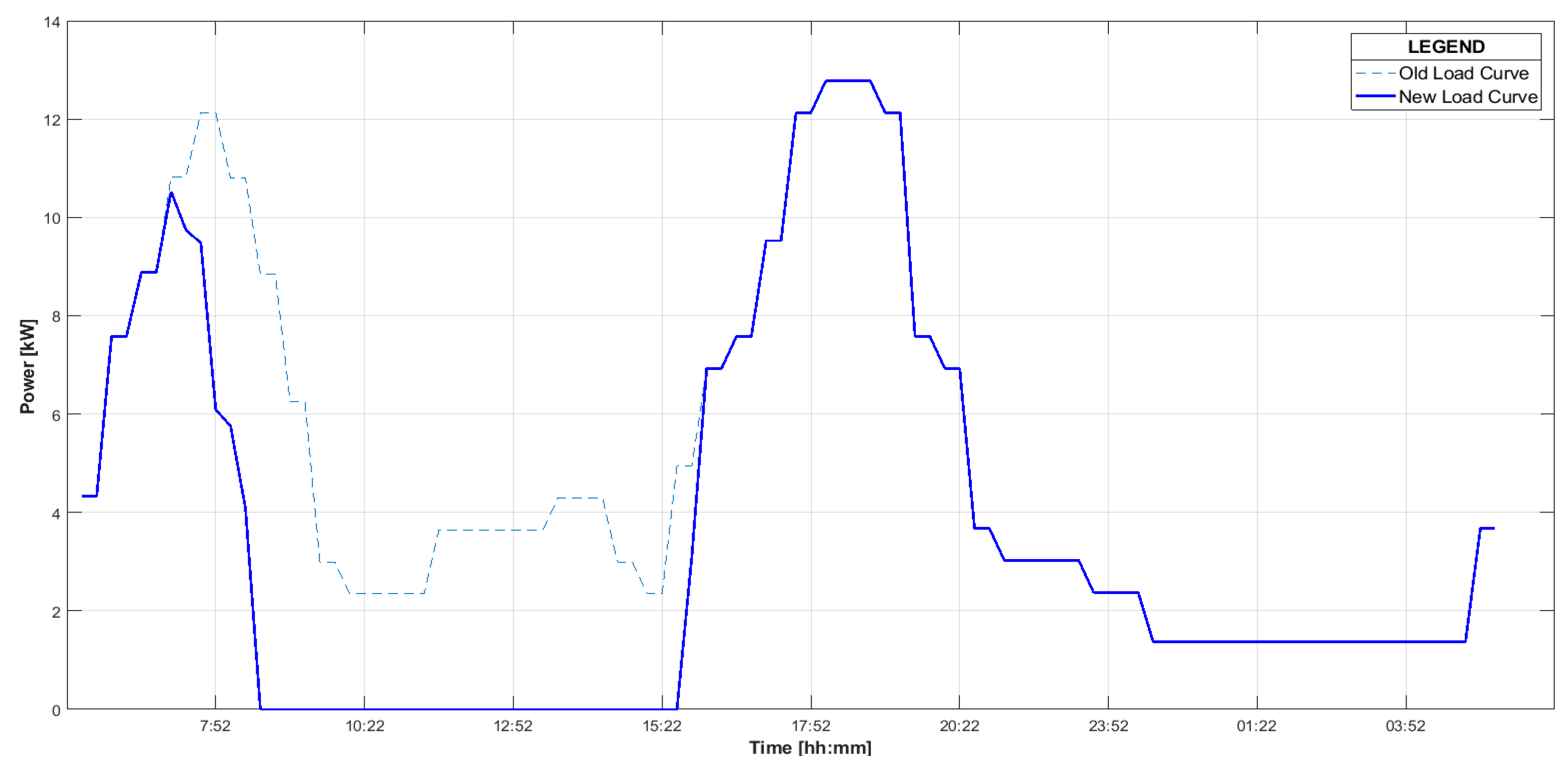
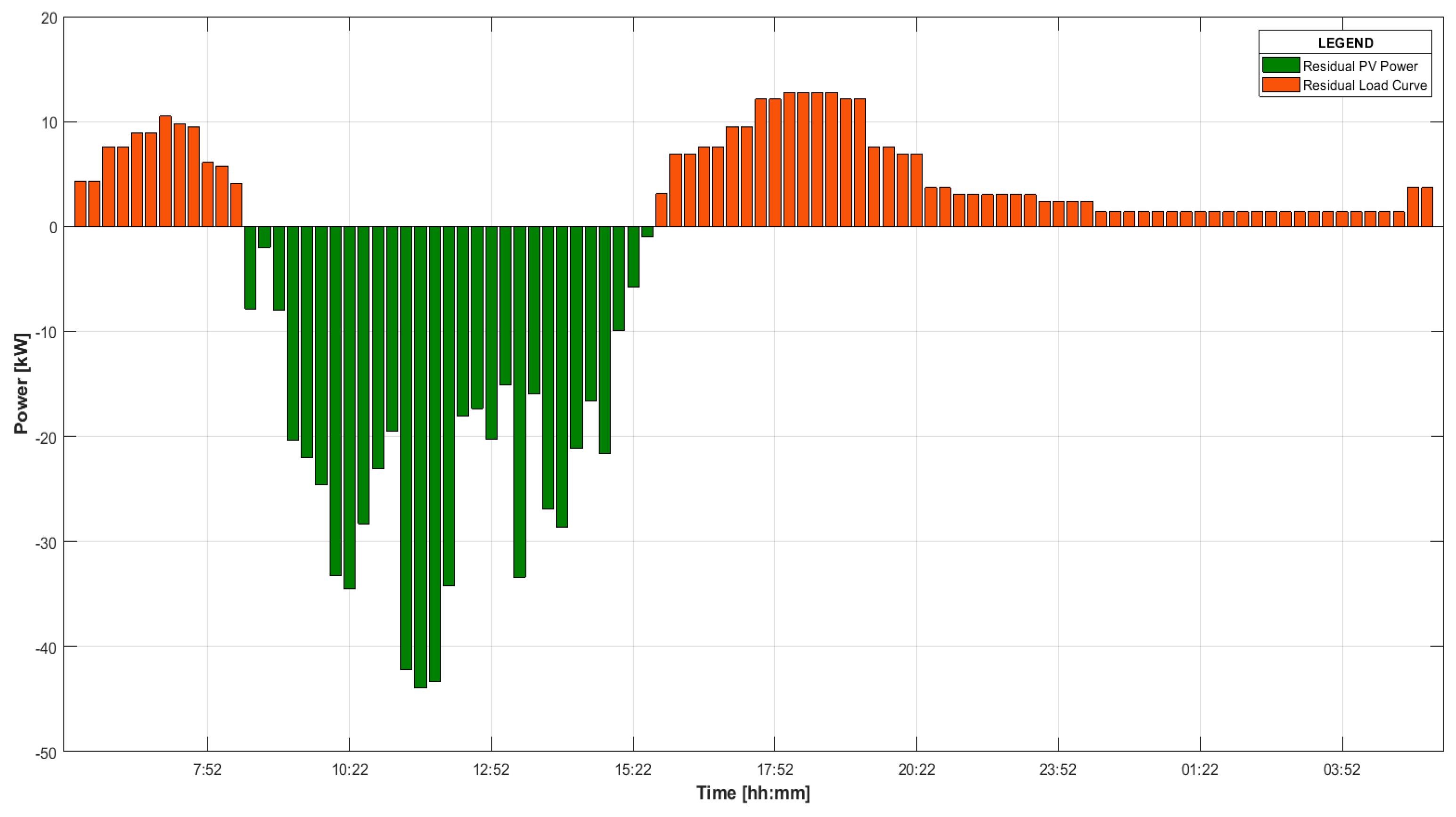

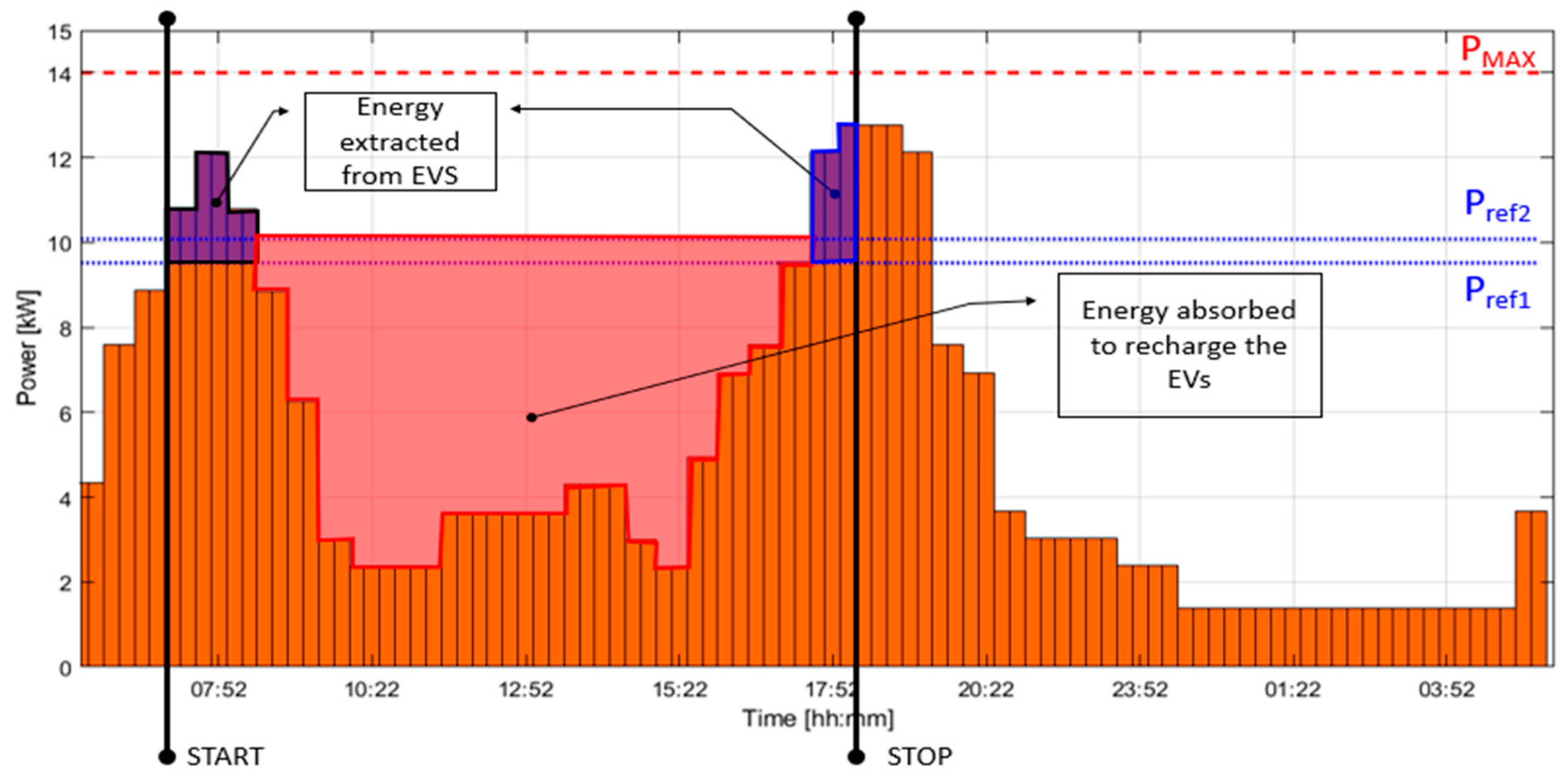

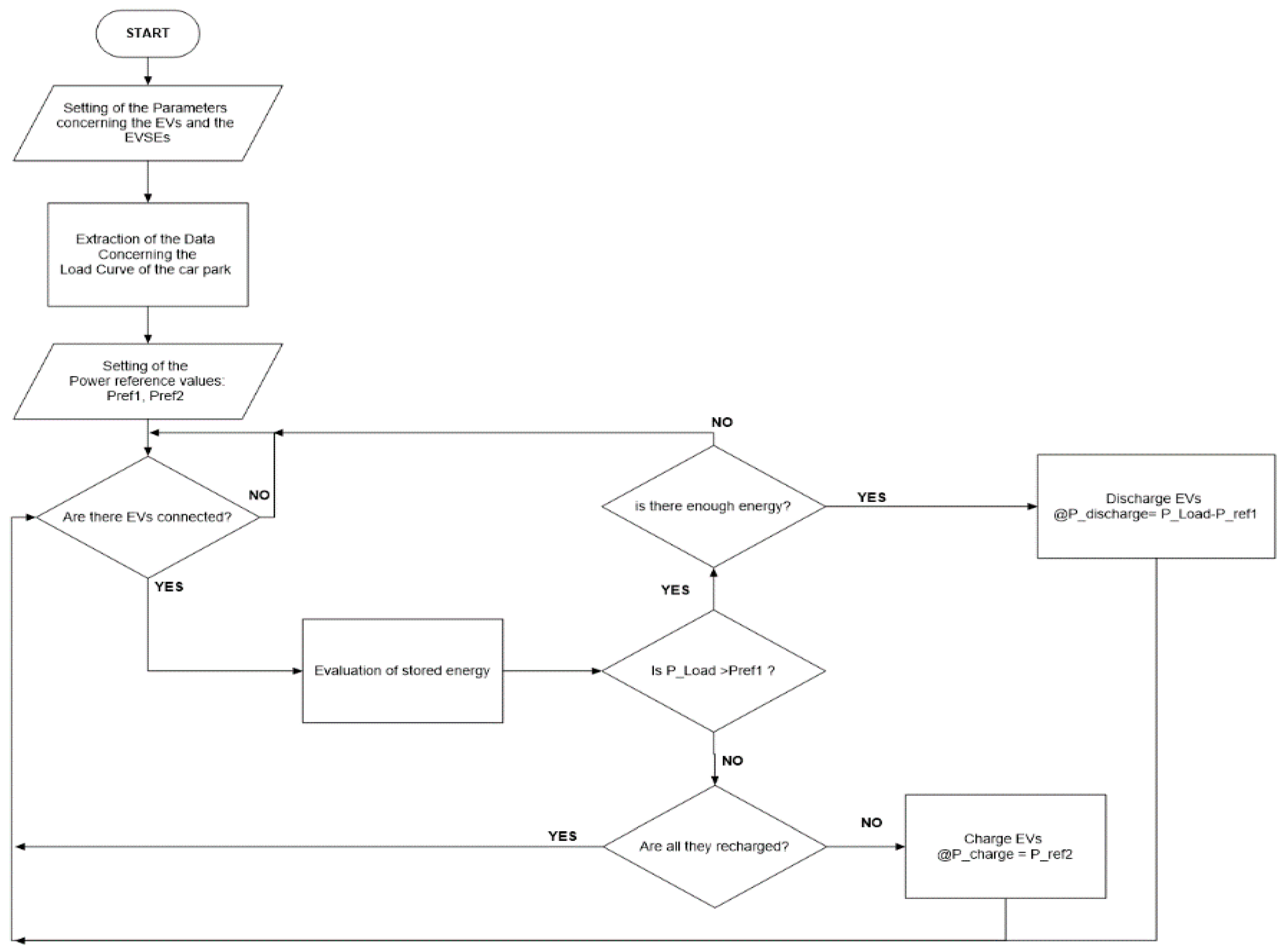
| Parameter | Value | |
|---|---|---|
| Battery capacity | 40 | [kWh] |
| Charge power/Type 2 | 6.6 | [kW], 1 or 3-phase |
| Fastcharge port/CHAdeMO type | 50 | [kW], DC |
| Input voltage | 360 | [V] |
| Vehicle consumption 1 | 236 | [Wh/km] |
| Parameter | Basic Consumption | Consumption with EVs |
|---|---|---|
| Daily energy absorption [kWh] | 118.2 | 328.2 |
| Monthly energy absorption [MWh] | 3.55 | 9.85 |
| Annual energy absorption [MWh] | 43.1 | 119.8 |
| Case | String | Inverter | Condition | |
|---|---|---|---|---|
| 1 | The minimum output voltage of the string (the one corresponding to +70 °C) must be greater than the activation voltage of the inverter. | |||
| 2 | The maximum output voltage of the string (the one corresponding to −10 °C) must be lower than the maximum Maximum Power Point (MPP) input voltage tolerable by the inverter. | |||
| 3 | The maximum open circuit voltage of the string (the one corresponding to −10 °C) must be lower than the maximum input voltage tolerable by the inverter. | |||
| 4 | The sum of all the N-string currents must be lower than the maximum input current tolerable by the inverter. | |||
| 5 | The total power of the M panels connected to the inverter must be less than its nominal power |
| String | Inverter | ||
|---|---|---|---|
| @25°C | |||
| @25°C | |||
| @70°C | |||
| @−10°C | |||
| ✔ | @−10°C | ||
| ✔ | = 94.3 A | ||
| ✔ | |||
© 2020 by the authors. Licensee MDPI, Basel, Switzerland. This article is an open access article distributed under the terms and conditions of the Creative Commons Attribution (CC BY) license (http://creativecommons.org/licenses/by/4.0/).
Share and Cite
Garruto, R.; Longo, M.; Yaïci, W.; Foiadelli, F. Connecting Parking Facilities to the Electric Grid: A Vehicle-to-Grid Feasibility Study in a Railway Station’s Car Park. Energies 2020, 13, 3083. https://doi.org/10.3390/en13123083
Garruto R, Longo M, Yaïci W, Foiadelli F. Connecting Parking Facilities to the Electric Grid: A Vehicle-to-Grid Feasibility Study in a Railway Station’s Car Park. Energies. 2020; 13(12):3083. https://doi.org/10.3390/en13123083
Chicago/Turabian StyleGarruto, Ruben, Michela Longo, Wahiba Yaïci, and Federica Foiadelli. 2020. "Connecting Parking Facilities to the Electric Grid: A Vehicle-to-Grid Feasibility Study in a Railway Station’s Car Park" Energies 13, no. 12: 3083. https://doi.org/10.3390/en13123083








